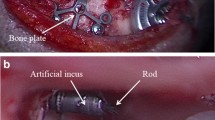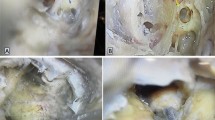Abstract
Purpose
This research was designed to aid practical otologic studies of the human middle ear. The topographic anatomy access of the middle ear was described with special focus to the cochlear implant procedure. It was conducted in an attempt to elucidate factors that would ultimately determine the ease of insertion of an electrode array.
Methods
Fifteen right and 12 left temporal bones were dissected under the surgical microscope. After performing appropriate incisions, the distances between the stapedius muscle tendon, incus long crus and the cochleostomy were measured with the help of a digital microscope (Dino-Lite plus®).
Results
After performing statistical analysis, we found that strong relationship exists in the distances between the measured anatomical landmarks.
Conclusion
Microscopic anatomical studies of the temporal bone are essential to safely perform surgical intervention within the middle ear. The results shows that morphometric data concerning different anatomical structures inside the middle ear, particularly distances, is an important contribution towards the planning of safe surgical procedures.



Similar content being viewed by others
References
Anagnostopoulou S, Diamantopoulou P (2004) Topographic relationship between the cochlea and the middle fossa floor: the anatomical basis for an alternative approach to the cochlear turns. Surg Radiol Anat 26(2):82–85
Aslan A, Mutlu C, Celik O, Govsa F, Ozgur T, Egrilmez M (2004) Surgical implications of anatomical landmarks on the lateral surface of the mastoid bone. Surg Radiol Anat 26(4):263–267
Barrs DM, Trahan CJ, Casey K, Brooks D (1991) The porcine model for intratemporal facial nerve trauma studies. Otolaryngol Head Neck Surg 105(6):845–856
Bogar M, Bento RF, Tsuji RK (2008) Cochlear anatomy study used to design surgical instruments for cochlear implants with two bundles of electrodes in ossified cochleas. Braz J Otorhinolaryngol 74(2):194–199
Borin A, Covolan L, Mello LE, Okada DM, Cruz OL, Testa JR (2008) Anatomical study of a temporal bone from a non-human primate (Callithrix sp.). Braz J Otorhinolaryngol 74(3):370–373
Eby TL (1989) Advances in otologic microsurgery. Microsurgery 10(4):333–337
Goravalingappa R (2002) Cochlear implant electrode insertion: Jacobson’ nerve, a useful anatomical landmark. Indian J Otol Head Neck Surg 54:70–73
Judkins RF, Hongyan L (1997) Surgical anatomy of the rat middle ear. Otolaryngol Head Neck Surg 117(5):438–447
Penido NO, Borin A, Fukuda Y, Lion CN (2005) Microscopic anatomy of the carotid canal and its relations with cochlea and middle ear. Braz J Otorhinolaryngol 71(4):410–414
Sichel JY, Plotnik M, Cherny L, Sohmer H, Elidan J (1999) Surgical anatomy of the ear of the fat sand rat. J Otolaryngol 28(4):217–222
Ulla MB, Vázquez F, Pumar JM, Del Rio M, Romero G (2009) Oblique multiplanar reformation in multislice temporal bone CT. Surg Radiol Anat 31(6):475–479
Vlastou C (2006) Facial paralysis. Microsurgery 26(4):278–287
Zielinsky P, Stoniewski P (2001) Virtual modelling of the surgical anatomy of the petrous bone. Folia Morphol 60(4):343–346
Acknowledgments
The authors would like to thank the team of otorhinolaryngologists at HRAC/USP/Brazil (Centrinho) for their constant assistance during this study. Special thanks to Heitor Marques Honório, PhD (Department of Pediatric Dentistry, Orthodontics and Collective Health-Statistic, FOB/USP/Brazil) for helping us with the statistical analysis.
Conflict of interest
The authors declare that they have no conflict of interest.
Author information
Authors and Affiliations
Corresponding author
Rights and permissions
About this article
Cite this article
de Castro Rodrigues, A., Shinohara, A.L., Andreo, J.C. et al. Surgical anatomy of the human middle ear: an insight into cochlear implant surgery. Surg Radiol Anat 34, 535–538 (2012). https://doi.org/10.1007/s00276-012-0947-6
Received:
Accepted:
Published:
Issue Date:
DOI: https://doi.org/10.1007/s00276-012-0947-6




